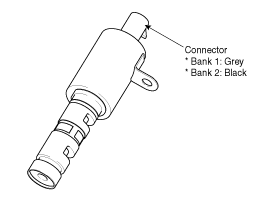Kia Cadenza: Engine Control System / CVVT Oil Control Valve (OCV) Description and Operation
Kia Cadenza YG 2016-2025 Service Manual / Engine Control / Fuel System / Engine Control System / CVVT Oil Control Valve (OCV) Description and Operation
| Description |
Continuous Variable Valve Timing (CVVT) system advances or
retards the valve timing of the intake and exhaust valve in accordance
with the ECM control signal which is calculated by the engine speed and
load.
By controlling CVVT, the valve over-lap or under-lap occurs,
which makes better fuel economy and reduces exhaust gases (NOx, HC) and
improves engine performance through reduction of pumping loss, internal
EGR effect, improvement of combustion stability, improvement of
volumetric efficiency, and increase of expansion work.
This system consist of
- the CVVT Oil Control Valve (OCV) which supplies the engine
oil to the cam phaser or runs out the engine oil from the cam phaser in
accordance with the ECM PWM (Pulse With Modulation) control signal,
- the CVVT Oil Temperature Sensor (OTS) which measures the engine oil temperature,
- and the Cam Phaser which varies the cam phase by using the hydraulic force of the engine oil.
The engine oil getting out of the CVVT oil control valve
varies the cam phase in the direction (Intake Advance/Exhaust Retard) or
opposite direction (Intake Retard/Exhaust Advance) of the engine
rotation by rotating the rotor connected with the camshaft inside the
cam phaser.

 Purge Control Solenoid Valve (PCSV) Repair procedures
Purge Control Solenoid Valve (PCSV) Repair procedures
Inspection
1.
Turn the ignition switch OFF.
2.
Disconnect the PCSV connector.
3.
Measure resistance between the PCSV terminals 1 and 2.
4.
Check that the resistance is within the speci ...
 CVVT Oil Control Valve (OCV) Specifications
CVVT Oil Control Valve (OCV) Specifications
Specification
ItemSpecificationCoil Resistance (Ω)9.4 ~ 10.4 [20°C(68°F)]
...
Other information:
Kia Cadenza YG 2016-2025 Service Manual: Alternator Repair procedures
Removal 1. Disconnect the battery negative terminal. 2. Remove the engine cover. 3. Disconnect the alternator connector (A) and cable (B) from the ''B'' terminal. 4. To release the tension, turn the drive belt tensioner counterclockwise then remove the drive belt (A). 5. Remove ...
Kia Cadenza YG 2016-2025 Owners Manual: Blind-Spot Collision Warning
First stage alert If a vehicle is detected within the boundary of the system, a warning light will illuminate on the outside rearview mirror. Once the detected vehicle is no longer within the blind spot area, the warning will turn off according to the driving conditions of the vehicl ...
Copyright © www.kcadenzavg.com 2017-2025

